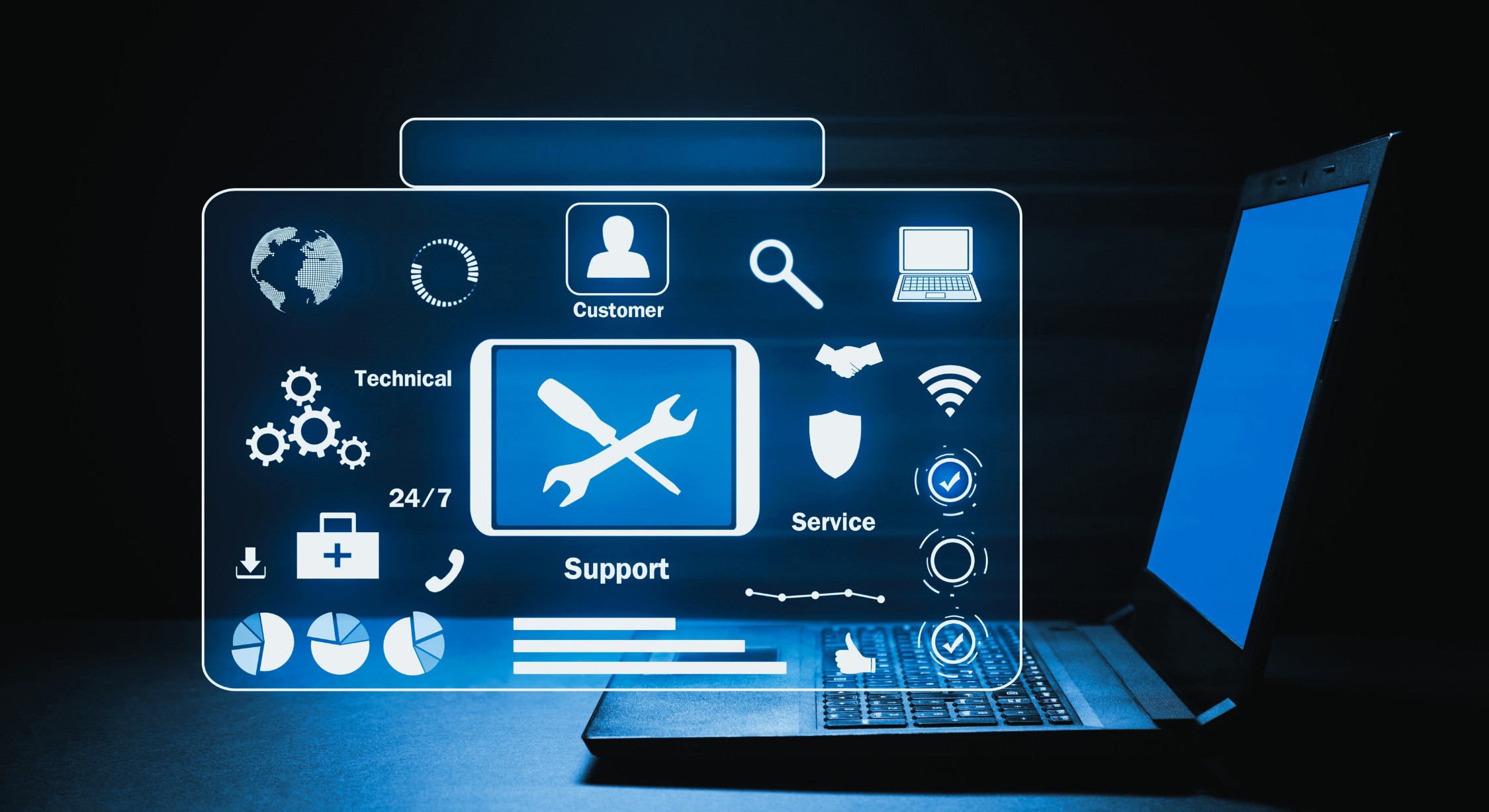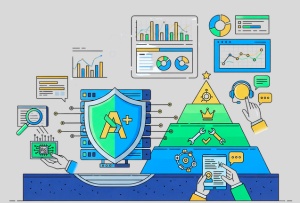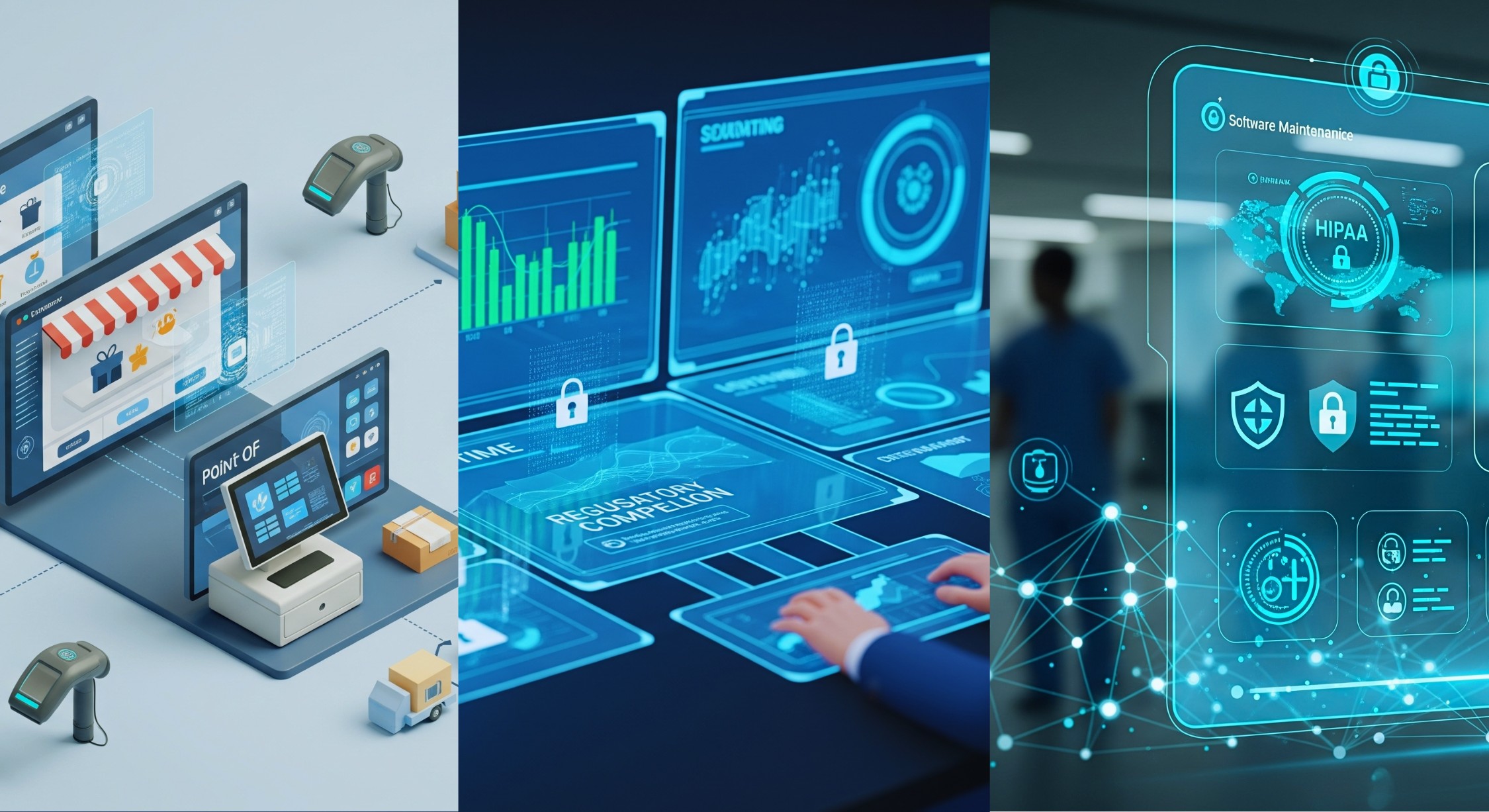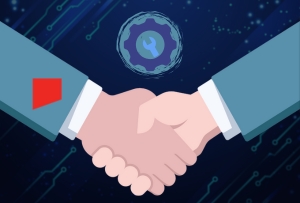Extend the life of your software with Experion’s reliable, secure, and cost-effective support solutions.
Picture this: your team rolls out a sleek new software application. It’s met with positive feedback, user adoption is high, and the business impact is immediate. For a while, everything runs smoothly. But as time passes, users begin to report glitches. Performance slows down, a few security alerts pop up, and new compliance requirements surface. Eventually, customer satisfaction starts to decline. So, what went wrong?
The truth is, building and launching software is only half the journey. The real challenge lies in keeping it running at peak performance in an ever-evolving technology landscape. This is where software maintenance and support services become essential.
Just like a vehicle that performs best when regularly serviced, software applications need consistent upkeep to stay secure, compatible, and efficient. Without regular updates, patches, and enhancements, even the best software can become outdated, vulnerable, and underwhelming for users.
As digital transformation accelerates across industries, businesses are beginning to understand that software development does not end at deployment. Maintaining software quality, performance, and security over time has become just as important, if not more, than the initial build.
This shift in mindset has led to a growing demand for structured software maintenance services and comprehensive IT support services that focus on post-launch performance, adaptability, and user satisfaction. Investing in these services is no longer optional for companies aiming to scale confidently and sustain long-term success in a competitive digital world.
With the right support model in place, organizations can respond quickly to change, minimize downtime, and provide a consistently smooth user experience, while also keeping costs in check and risks at bay. That is the power of dependable software maintenance and support.
What Are Software Maintenance and Support Services?

Software maintenance and support services encompass a wide range of ongoing activities that begin once a software product has been deployed. The goal of these services is to ensure that the software continues to perform optimally, remains secure against emerging threats, and adapts seamlessly to evolving user requirements and technological environments.
These services include a combination of corrective actions such as bug fixes, adaptive updates to accommodate changes in operating systems or hardware, perfective enhancements based on user feedback, and preve
ntive measures that mitigate future risks. Together, they help in extending the software’s lifespan, maintaining high availability, and ensuring consistent performance.
In addition to technical maintenance, software support services provide real-time assistance to users through help desks, issue resolution systems, and performance monitoring. This continuous support not only keeps the application running smoothly but also builds user confidence and loyalty. As businesses increasingly depend on digital systems to drive operations, having a structured maintenance and support strategy is no longer a luxury—it is a necessity.
Difference Between Software Development and Maintenance
 The distinction between software development and software maintenance lies in their core objectives and timelines. Software development is typically project-based, with a clear starting point and an end goal of delivering a functional product that meets specific business requirements. This phase includes designing the architecture, writing code, conducting testing, and launching the final application.
The distinction between software development and software maintenance lies in their core objectives and timelines. Software development is typically project-based, with a clear starting point and an end goal of delivering a functional product that meets specific business requirements. This phase includes designing the architecture, writing code, conducting testing, and launching the final application.
On the other hand, software maintenance begins where development ends. Once the software is released, it enters a dynamic phase where it must be monitored, adjusted, and improved continuously. Maintenance is not a single task but an ongoing process that ensures the software continues to meet its intended purpose as user expectations evolve and technology changes.
For example, a mobile banking app may be developed to offer core features like balance checks and transfers. However, over time, it will need updates for security patches, compatibility with new smartphone operating systems, new regulatory requirements, and additional features driven by user demand. All of this falls under the scope of maintenance.
In short, development delivers the product, while maintenance ensures its longevity, reliability, and relevance in a constantly changing environment.
Why Businesses Need Ongoing Support?
In today’s fast-moving digital world, software that is not actively maintained and supported can quickly become outdated, vulnerable, or misaligned with business goals. Ongoing software support services are essential to keep systems running smoothly and delivering value consistently. Here’s why continuous support is critical for modern businesses:
- Technology Continues to Evolve:
New operating systems, browsers, devices, and third-party integrations are released frequently. Without regular updates, your software may face compatibility issues, leading to reduced functionality and user frustration. Keeping pace with these changes ensures that your applications stay relevant and efficient. - User Expectations Are Constantly Rising:
Today’s users expect seamless experiences, fast performance, and intuitive features. Ongoing support allows businesses to incorporate user feedback, fine-tune the interface, and introduce enhancements that keep users satisfied and engaged. - Security Threats Are Becoming More Complex:
With cyberattacks growing in frequency and sophistication, outdated software becomes an easy target. Regular security patches, vulnerability monitoring, and compliance updates are essential to safeguard sensitive data and maintain user trust. - Downtime Can Be Extremely Costly:
Even a few hours of unplanned downtime can result in revenue loss, productivity decline, and reputational damage. Having a reliable software support system in place ensures that issues are detected and resolved quickly, minimizing disruption to business operations.
Proactive and responsive support not only helps in keeping systems up and running but also creates a solid foundation for growth and innovation.
Types of Software Maintenance
To manage applications effectively over time, businesses need to understand the four main types of software maintenance services, each serving a distinct purpose. Recognizing these categories helps in creating a balanced maintenance strategy aligned with technical and business needs.
- Corrective Maintenance:
This type of maintenance addresses defects and issues discovered after the software has been deployed. It includes fixing bugs, resolving functional inconsistencies, and correcting errors in the logic or design that affect performance or usability. Prompt corrective maintenance ensures smooth user experiences and reliable operations.
- Adaptive Maintenance:
Technology never stands still. Adaptive maintenance encompasses modifying the software so it remains compatible with evolving external environments. This includes changes in hardware, operating systems, databases, APIs, or third-party services. Through adaptive maintenance, software stays aligned with current infrastructure and avoids disruptions caused by incompatibility. - Perfective Maintenance:
Over time, user needs and business priorities change. Perfective maintenance focuses on enhancing existing functionalities, improving user interfaces, optimizing performance, and adding new features. These refinements help the software remain competitive and valuable, encouraging higher user engagement and satisfaction. - Preventive Maintenance:
Rather than waiting for problems to surface, preventive maintenance anticipates potential issues and addresses them before they escalate. This includes refactoring code, updating libraries, and performing regular audits to detect early warning signs. Preventive actions reduce the risk of failures, extend software longevity, and lower future maintenance costs.
A successful software maintenance plan typically blends all four types, ensuring that applications remain functional, adaptive, high-performing, and secure throughout their lifecycle.
Benefits of Regular Software Maintenance
Committing to consistent software maintenance services is a strategic investment that delivers long-term advantages across performance, security, and operational costs. Here are some of the key benefits businesses can expect from regular maintenance:
- Improved System Performance:
Regular performance tuning, database optimization, and code cleanup ensure that your application remains responsive, efficient, and scalable. Smooth functionality leads to better user experiences and reduces frustration among end users. - Reduced Downtime:
Proactive detection and resolution of issues through scheduled health checks and monitoring prevent unexpected failures. By identifying weak points early, businesses can minimize service disruptions and maintain continuous operations. - Enhanced Security:
Cyber threats are constantly evolving, and outdated software is particularly vulnerable to attacks. Applying timely patches, updates, and security fixes protects sensitive data and ensures compliance with industry standards and regulations. - Long-term Cost Savings:
Preventive maintenance helps detect potential issues before they become major problems, avoiding the high costs associated with emergency fixes, data loss, or system rebuilds. A small, regular investment in maintenance can significantly reduce future expenses and resource strain.
In essence, regular maintenance preserves the value of your software, enhances user trust, and helps the business stay agile in the face of change.
Deep Dive into Software Support Services
 While maintenance ensures the structural integrity and evolution of your software, software support services focus on providing timely and effective assistance to users when issues arise. Support plays a crucial role in user satisfaction, operational efficiency, and business resilience.
While maintenance ensures the structural integrity and evolution of your software, software support services focus on providing timely and effective assistance to users when issues arise. Support plays a crucial role in user satisfaction, operational efficiency, and business resilience.
Importance of Proactive Support Services
Modern businesses can no longer afford to wait until something breaks before taking action. Proactive support is about anticipating problems and responding in real time. Here’s why it matters:
- Real-Time Issue Handling:
A responsive support team can quickly detect and resolve problems as they occur, minimizing downtime and user inconvenience. This helps maintain productivity and customer trust, especially in mission-critical environments. - User Satisfaction and Retention:
Users who receive prompt and effective support are more likely to remain loyal to your product or platform. High-quality support enhances the overall user experience and strengthens your reputation in the market. - Business Continuity:
Reliable support ensures that your systems stay operational and interruptions are minimized. This continuity is vital for customer-facing applications and internal systems alike, where even brief outages can result in revenue loss or reputational damage.
Common Support Service Activities
Effective software support services involve a variety of day-to-day operations that address both technical and user-facing challenges:
- Help Desk and Ticket Management:
A structured system for logging, categorizing, and prioritizing user issues ensures that problems are addressed efficiently and transparently. - Technical Troubleshooting:
Diagnosing and resolving system-related issues, whether related to backend logic, server load, or integration points, ensures uninterrupted functionality. - Continuous Monitoring and Alerts:
Real-time system monitoring helps detect anomalies or performance degradation early. Automated alerts enable quick action before users are impacted. - Patch Management and Update Deployment:
Regular updates not only improve performance but also resolve known bugs and vulnerabilities. Ensuring smooth deployment across environments helps maintain application stability.
Levels of Software Support
Support services are typically structured in tiers, each designed to handle different levels of complexity:
- Level 1 Support:
This is the first point of contact, offering basic assistance for general queries and common issues. Support agents at this level handle user guidance, account management, and frequently asked questions. - Level 2 Support:
When issues require technical analysis or in-depth troubleshooting, Level 2 support teams step in. They possess more specialized knowledge and access to logs, system configurations, and tools necessary to diagnose and resolve recurring or moderate issues. - Level 3 Support:
This level involves expert intervention from software engineers, product developers, or system architects. They handle complex, high-impact issues that often require code-level changes or infrastructure adjustments.
Having a clear escalation path ensures that problems are addressed by the right team at the right time, leading to quicker resolutions and better resource management.
KPIs and Metrics for Effective Support
To measure the effectiveness of software support services, organizations rely on a set of performance indicators. These metrics provide valuable insights into service quality and help identify areas for improvement:
- Response Time:
Measures the duration between a user raising a support request and the support team’s first acknowledgment. Quick response time indicates better attentiveness and user engagement. - Resolution Time:
Tracks how long it takes to fully resolve an issue from the time it was reported. Faster resolution times help maintain productivity and user satisfaction. - Customer Satisfaction Score (CSAT):
This is typically gathered through post-resolution surveys and reflects how satisfied users are with the support they received. High CSAT scores indicate effective communication and problem-solving. - Mean Time to Resolution (MTTR):
A critical metric that averages the time taken to resolve various support issues. It reflects the efficiency and preparedness of the support team in handling a range of incidents.
By continuously monitoring and improving these KPIs, businesses can ensure their software maintenance and support strategy delivers consistent, high-quality service to users and stakeholders.
Key Components of a Software Maintenance and Support Strategy
Developing a robust software maintenance and support strategy requires more than just technical expertise. It involves a carefully coordinated framework that aligns business needs, user expectations, and service delivery goals. Here are the foundational components that make such a strategy successful:
- Service Level Agreements (SLAs):
SLAs are formal agreements that outline the scope of services, expected response and resolution times, performance benchmarks, and accountability mechanisms. These agreements help ensure that both the service provider and the client are aligned on expectations, responsibilities, and quality standards.
- Incident and Problem Management:
A structured process for logging, categorizing, and resolving incidents ensures minimal disruption to users. By identifying root causes and implementing long-term fixes, teams can reduce the recurrence of issues and enhance system reliability over time. - Documentation and Knowledge Base:
Maintaining comprehensive documentation—including system architecture, codebase notes, and resolution histories—empowers both internal teams and external users. A well-organized knowledge base promotes self-service, reduces the number of tickets, and speeds up the onboarding of new support personnel. - Backup and Disaster Recovery Plans:
Unexpected failures or security breaches can result in significant data loss and operational downtime. A robust backup strategy, combined with a clearly defined disaster recovery plan, ensures that critical data is preserved and services are quickly restored during emergencies.
Experion’s comprehensive support framework integrates all of these components to deliver proactive, scalable, and resilient support. Our approach ensures that your business-critical applications are always available, optimized for performance, and ready to evolve with your growth.
Industry Use Cases – Software Maintenance and Support

The value of software maintenance and support services extends across industries, helping organizations sustain compliance, manage complexity, and deliver consistent user experiences. Below are a few sector-specific examples:
- Healthcare:
In the healthcare industry, software applications must comply with stringent regulations such as HIPAA or GDPR. Regular updates ensure that systems stay compliant, secure, and integrated with evolving health technologies like electronic health records (EHRs), telemedicine platforms, and IoT-enabled devices. - Finance:
Financial institutions rely on mission-critical software for transactions, risk assessment, and customer engagement. Ongoing support is essential to maintain system security, ensure zero downtime, and meet regulatory requirements across multiple jurisdictions. - Retail:
Retail businesses need their eCommerce platforms and point-of-sale systems to function seamlessly, especially during peak seasons. Software support ensures smooth integration with payment gateways, inventory systems, and third-party logistics, as well as quick responses to spikes in user activity.
Our clients across these industries have reported measurable improvements after engaging Experion for structured support. Many have experienced up to 30 percent reduction in system downtime and 40 percent faster issue resolution, resulting in better customer experiences and lower operational risk.
Challenges in Implementing Software Maintenance and Support Services
While the advantages of a maintenance and support strategy are clear, businesses often face several obstacles during implementation. Addressing these challenges early is key to long-term success.
- Legacy Systems Compatibility:
Many enterprises still operate on legacy platforms that were not built to integrate with modern tools or cloud infrastructure. Maintaining such systems requires specialized expertise and often involves custom workarounds to ensure compatibility without disrupting business operations. - Keeping Pace with Technological Evolution:
The rapid evolution of software technologies, frameworks, and security protocols demands ongoing learning and adaptation. Support teams must regularly update their skills and stay informed about industry trends to keep systems current and resilient. - Knowledge Transfer Issues:
When support teams change or external vendors are involved, the lack of detailed documentation or standardized handover processes can lead to inefficiencies. Important insights about system behavior, past incidents, and custom configurations may be lost, increasing the time required to resolve future issues.
At Experion, we help our clients navigate these challenges by offering transition support, legacy modernization services, and detailed system documentation as part of our engagement model. This ensures that your systems are not only supported but continuously improved over time.
Future Trends in Software Maintenance and Support Services

As businesses continue to adopt emerging technologies and digital infrastructures become more complex, software maintenance and support services are undergoing a major transformation. New tools and approaches are reshaping how organizations manage and sustain their software systems. Here are the key trends defining the future of this space:
- AI-Powered Predictive Maintenance:
Artificial intelligence and machine learning are enabling systems to analyze patterns, detect anomalies, and predict potential failures before they occur. By leveraging predictive analytics, businesses can take corrective action in advance, reducing unplanned downtime and improving software reliability. - Chatbots and Virtual Agents:
Intelligent chatbots are increasingly being used to automate first-level support. These virtual agents can resolve basic user queries, log incidents, and even guide users through simple troubleshooting steps. This reduces response times and allows human support teams to focus on more complex issues. - Self-Healing Applications:
Modern applications are being designed with the capability to detect and resolve known issues on their own. These self-healing mechanisms can restart services, reallocate resources, or apply fixes based on predefined rules, reducing the need for manual intervention and ensuring continuous availability. - Cloud-Based Maintenance:
The shift to cloud environments has introduced centralized, scalable, and highly flexible support models. Cloud-based maintenance enables easier deployment of updates, seamless monitoring across distributed systems, and faster access to performance data, enhancing support agility. - Low-Code and No-Code Platforms:
These platforms are simplifying the way applications are developed and maintained. With drag-and-drop functionality and reusable components, teams can implement updates and improvements faster, while reducing dependency on large development teams or complex coding processes. - Proactive Security Focus:
With cybersecurity threats becoming more sophisticated, the future of support services will be security-first by design. Regular vulnerability assessments, integrated security updates, and automated compliance checks will be embedded throughout the software development and maintenance lifecycle.
Staying ahead of these trends not only helps reduce risks and costs, but also ensures that businesses are better positioned to meet user expectations and scale their digital capabilities.
Choosing the Right Partner for Software Maintenance and Support Services
Selecting the right partner for software maintenance and support is a strategic decision that can significantly impact your organization’s ability to operate, innovate, and grow. A well-qualified partner provides more than just technical expertise—they bring in a culture of accountability, agility, and customer-centric service.
Evaluation Criteria
When evaluating vendors, consider the following key factors:
- Technical Expertise and Toolset:
Ensure the partner has experience with the technologies you use, along with access to advanced monitoring, automation, and issue-tracking tools. - Industry-Specific Experience:
Look for familiarity with your sector’s regulatory, operational, and security requirements. A partner with domain expertise will be better equipped to tailor support strategies to your needs. - Proven Track Record and Client Testimonials:
Evaluate past projects, case studies, and client feedback. A partner with a history of delivering consistent, high-quality service is more likely to align with your expectations.
Questions to Ask Vendors
To assess the vendor’s capability and approach, ask them:
- What is your escalation matrix for handling critical issues?
- How do you ensure a proactive rather than reactive support model?
- What metrics or KPIs do you use to measure success and service quality?
In-House vs Outsourced Support
While in-house support gives you more control, it often requires higher investment in tools, training, and resources. Outsourcing offers several advantages:
- Tap into an extensive talent base offering niche skills.
- Lower costs due to shared infrastructure and optimized processes
- 24/7 availability and global delivery models for round-the-clock support
A hybrid approach may also work well, depending on the complexity and scale of your operations.
How Experion Can Offer Support in Software Maintenance and Support Services
 At Experion, we understand that maintaining software is just as important as building it. With over 19 years of global experience, we deliver comprehensive software maintenance and support services that help our clients stay ahead in an increasingly competitive and digital-first marketplace.
At Experion, we understand that maintaining software is just as important as building it. With over 19 years of global experience, we deliver comprehensive software maintenance and support services that help our clients stay ahead in an increasingly competitive and digital-first marketplace.
Here’s how we make a difference:
- Scalable Offshore Delivery Model:
We enable rapid team ramp-up with experienced professionals who align with your processes and timelines. Our delivery centers operate with high efficiency and strong governance, allowing you to scale support as your business evolves. - Cost-Effective Operations Without Compromising Quality:
Our support strategies are designed to optimize resource usage while maintaining a high level of service excellence. By leveraging automation, agile methodologies, and domain expertise, we ensure you get the best value for your investment. - Performance, Compliance, and User Satisfaction at the Core:
Our teams are trained to monitor system health, resolve incidents promptly, and ensure compliance with industry standards. We focus not only on fixing problems but on creating a seamless and satisfying user experience.
Experion has partnered with organizations around the world across industries such as healthcare, finance, retail, and wellness. We have supported digital platforms used by millions and maintained mission-critical systems with zero tolerance for downtime.
From being the digital transformation partner for the world’s largest motorcycle manufacturer, to managing the support lifecycles of enterprise applications in Europe and the United States, we have built a reputation for reliability, agility, and long-term impact.
Conclusion
Software maintenance and support services are no longer optional add-ons at the end of the development cycle, they are critical pillars of sustainable digital operations. As your software ecosystem grows in complexity and integrates with evolving technologies, the need to proactively manage its health, performance, and security becomes even more vital.
Whether you’re supporting a mission-critical financial platform, a high-traffic eCommerce system, or a healthcare application that handles sensitive data, ensuring continuity and reliability is essential. Without consistent maintenance and support, even the most innovative applications can become liabilities rather than assets.
By integrating a comprehensive support strategy into the software development lifecycle, businesses can not only protect their digital investments but also gain the flexibility to innovate, adapt, and scale with confidence. Choosing an experienced partner like Experion Technologies helps transform support from a reactive necessity into a strategic advantage that fuels business growth, customer trust, and long-term success.
Key Takeaways
- Software maintenance improves performance, scalability, and operational resilience.
Regular updates and optimization keep applications fast, responsive, and capable of handling growing user demands. - Support services ensure system uptime, business continuity, and user satisfaction.
Real-time assistance and monitoring reduce disruptions and foster trust among customers and stakeholders. - A proactive maintenance strategy reduces long-term costs and prevents major system failures.
Identifying and fixing issues early is more efficient and cost-effective than responding to emergencies. - Security patching and compliance updates protect sensitive data and mitigate regulatory risks.
Continuous vigilance helps businesses stay ahead of threats and avoid costly breaches or penalties. - Adaptability through maintenance keeps your software aligned with evolving technologies.
Seamless integration with new platforms, APIs, and devices ensures your application remains relevant and competitive. - Preventive and perfective maintenance drive ongoing innovation and product improvement.
Leveraging user feedback and performance analytics allows you to refine features and enhance user experience over time. - Comprehensive documentation and knowledge management improve team efficiency and reduce onboarding time.
Well-documented systems allow smoother transitions and empower support teams to resolve issues faster. - Measurable KPIs such as MTTR and CSAT help continuously refine support strategies.
Tracking and analyzing support metrics ensures accountability and reveals areas for improvement. - Choosing the right maintenance and support partner enhances service quality and accelerates business outcomes.
A capable partner brings expertise, flexibility, and strategic insight that align technology with your business goals. - Experion offers a scalable, cost-effective, and high-performance support model tailored to global businesses.
With a proven track record across industries, Experion empowers clients to thrive through dependable, proactive support services.
Looking to strengthen your post-launch strategy?
Let Experion help you build resilient, future-ready software through robust software maintenance and support services.

